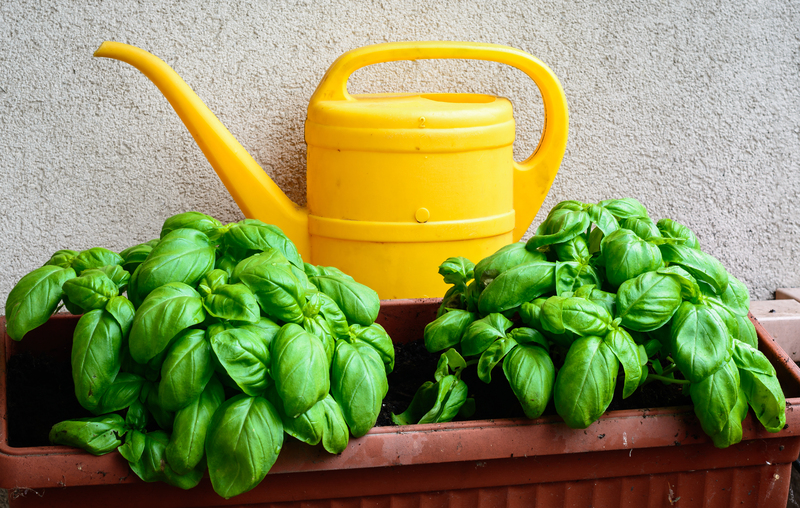Planting Power: Gardens and Climate Change Mitigation
Posted on 06/09/2025
Planting Power: Gardens and Climate Change Mitigation
Climate change is one of the most pressing challenges of our time, threatening ecosystems, economies, and communities worldwide. While addressing climate change requires global cooperation and systemic shifts, individual action plays a crucial role in promoting sustainability. One powerful and accessible way individuals and communities can contribute to the fight against climate change is by harnessing the transformative potential of gardens. This comprehensive article explores how gardening for climate change mitigation can make a significant impact.
Understanding the Role of Gardens in Climate Change Mitigation
When people think of climate solutions, large-scale projects and technological innovations often come to mind. However, every yard, balcony, rooftop, and community plot offers untapped potential for planting power. Gardens not only provide beauty and food but also act as living, breathing instruments for environmental change.
What Is Climate Change Mitigation?
Climate change mitigation refers to efforts to reduce or prevent the emission of greenhouse gases (GHGs), which are the primary drivers of global warming. Mitigation measures aim to slow the pace of climate change by:
- Lowering carbon dioxide (CO2) output
- Increasing carbon sequestration (the process by which carbon is captured and stored)
- Enhancing energy efficiency
- Reducing reliance on fossil fuels
Gardening may seem simple, but when practiced with climate-conscious strategies, it becomes a powerful tool for carbon management and ecological restoration.

The Science Behind Gardens and Carbon Sequestration
Plants absorb carbon dioxide from the atmosphere through photosynthesis. They utilize this CO2 to grow, thus locking carbon away in their leaves, stems, roots, and the soil. This process is known as carbon sequestration. Gardens, therefore, act as miniature carbon sinks, especially when they are planned and managed for maximum impact.
How Do Gardens Capture Carbon?
- Trees and Shrubs: Woody plants, such as trees and shrubs, have extensive root systems and bulkier aboveground growth, offering greater long-term carbon storage than annuals.
- Soil Health: Healthy soils teeming with organic matter and microorganisms can store enormous amounts of carbon, particularly when left undisturbed and covered with plants.
- Perennials vs. Annuals: Perennial plants live for multiple years and continue capturing and storing carbon without the need for frequent tilling, which releases CO2 back into the atmosphere.
For gardeners, this means every seed sown for climate, every mulch applied, and every compost pile nurtured supports the broader mission of gardening for a cooler planet.
Practical Ways Gardens Help in Climate Change Mitigation
Some gardening practices are particularly effective in reducing carbon footprints and supporting local microclimates. Here's how you can design a climate-smart garden:
1. Planting Trees and Shrubs
- Why it matters: Trees are the world's natural carbon-capture machines; a mature tree can absorb up to 48 pounds of CO2 each year.
- How to act: Choose native or drought-tolerant species that thrive in your local climate. Plant a mix of deciduous and evergreen trees to support year-round benefits.
2. Improving Soil Health
- Why it matters: Healthy, carbon-rich soil not only grows stronger plants but also sequesters more greenhouse gases.
- How to act: Add compost and organic matter, minimize soil disturbance, mulch, and avoid chemical fertilizers. Let nature take its course with cover crops and natural amendments.
3. Incorporating Perennials
- Why it matters: Perennials reduce the need for annual tilling and replanting. They anchor soils, prevent erosion, and capture carbon over many years.
- How to act: Grow fruit bushes, perennial herbs, ornamental grasses, and flowers. These add both functionality and beauty to your garden.
4. Reducing Water Use and Protecting Resources
- Why it matters: Watering gardens with fossil fuel-powered pumps or systems increases emissions. Also, water is a precious resource in a warming world.
- How to act: Install rain barrels, use drip irrigation, and landscape with drought-tolerant or native plants to conserve water.
5. Composting Organic Waste
- Why it matters: Composting diverts food and yard waste from landfills, where they would otherwise produce methane, a potent greenhouse gas. Finished compost enhances soil carbon storage.
- How to act: Set up a compost bin for food scraps, leaves, and grass clippings. Use the finished compost to feed your soil and plants.
6. Reducing Chemical Use
- Why it matters: Synthetic fertilizers and pesticides are usually energy-intensive to produce and often degrade soil health, undermining carbon sequestration efforts.
- How to act: Prioritize organic or natural methods of pest control and plant nutrition. Encourage beneficial insects and biodiversity.
7. Creating Biodiverse Habitats
- Why it matters: A diverse garden ecosystem sequesters more carbon and supports local wildlife, which plays an important role in soil health and nutrient cycles.
- How to act: Plant a variety of native flowers, shrubs, and trees. Avoid monocultures and provide habitat for pollinators and birds.
Edible Gardens and Local Food Production for Lower Emissions
Edible landscapes or home vegetable gardens offer climate benefits beyond carbon sequestration:
- Growing your own food reduces reliance on industrial agriculture, which is a major emitter of greenhouse gases due to synthetic fertilizers, pesticides, and transportation.
- Local produce requires fewer miles traveled, which means fewer emissions from transportation and storage.
- Gardeners can control their own inputs, opting for organic methods that protect both climate and health.
Urban gardening and rooftop farming are particularly impactful in densely populated areas. Not only do they foster community and increase access to fresh produce, but they also insulate buildings, reduce urban heat, and promote ecosystem services.
Gardens Combat the Urban Heat Island Effect
Urban areas, with their concrete and asphalt, absorb and retain heat, creating "urban heat islands." These higher temperatures can increase energy use, exacerbate air pollution, and pose health risks.
Planting power comes into play when green spaces such as gardens, parks, and green roofs help:
- Shade surfaces, reducing ambient heat
- Release moisture through transpiration, cooling the air
- Provide refuges for both people and wildlife
Strategic urban gardening not only mitigates temperature spikes but also beautifies and revitalizes cityscapes.
The Role of Community Gardens in Climate Solutions
Community gardens are collaborative spaces where neighbors come together to grow food, flowers, and relationships. These shared gardens have amplified impacts:
- Encourage climate education and sustainable practices among many people
- Support pollinators and local biodiversity
- Reduce social and environmental inequalities by providing green access in underserved neighborhoods
- Promote local food systems, reducing supply chain emissions
By fostering stewardship and participation, community gardens become living classrooms and climate action hubs for cities and suburbs alike.
Gardening for Biodiversity and Ecosystem Resilience
Biodiverse gardens are healthier, more resilient to climate extremes, and provide better carbon storage. By mimicking natural ecosystems, gardeners can:
- Increase the variety of above- and below-ground species
- Enhance soil microbe activity for better carbon capture
- Strengthen plants' resistance to pests and diseases, reducing the need for chemical interventions
Consider adding pollinator strips, hedgerows, native wildflower meadows, and wildlife-friendly water features to maximize your garden's ecosystem services and climate power.
Regenerative Gardening: Taking It Further
Regenerative gardening is an approach that goes beyond sustainability--it actively restores and improves ecological health while capturing carbon. Techniques include:
- No-dig or low-till gardening: Reduces carbon loss from soil disturbance and protects soil structure.
- Agroforestry and food forests: Integrate diverse layers of edible, medicinal, and native plants, maximally utilizing vertical and horizontal space for carbon storage.
- Biochar: A form of charcoal made from organic waste that, when added to soil, locks up carbon and improves soil fertility.
By adopting these methods, gardeners can become true climate heroes--helping heal the land, store more carbon, and produce food sustainably.
Climate-Responsive Plants: What to Grow for a Greener Planet
Certain plant choices maximize the climate benefit of gardens. Consider the following options for your sustainable garden:
Native Trees
- Oak
- Maple
- Willow
- Birch
Deep-rooted Perennials
- Prairie grasses (Big Bluestem, Switchgrass)
- Purple coneflower
- Black-eyed Susan
- Comfrey
Drought-tolerant Plants
- Lavender
- Thyme
- Sage
- Echinacea
Consult your local native plant society or extension office for ideas tailored to your region and climate zone. Choosing the right plants not only increases carbon storage but also supports thriving ecosystems year after year.
Overcoming Barriers: Tips for Climate-Conscious Gardening
- Space limitations? Try vertical gardens, container gardens, or balcony plantings.
- Poor soil? Build raised beds, amend with compost, and mulch regularly.
- Lack of time? Focus on low-maintenance perennials and mulching to suppress weeds and retain moisture.
- Learning curve? Many local gardening clubs, online forums, and extension services offer free advice and workshops for beginners.
- Community engagement: Team up with neighbors to start a community garden or a native plant restoration project.

The Ripple Effect: Beyond the Backyard
When you garden for climate change mitigation, you inspire positive change. Your actions encourage others to participate, creating a ripple effect through neighborhoods, towns, and communities. Not only does this multiply carbon sequestration, but it also fosters a sense of hope and agency in the face of climate challenges.
Schools, businesses, and cities that implement green landscaping, tree planting initiatives, and community plots become leaders in environmental stewardship. By advocating for public and private investment in green spaces, you help drive broader policy changes crucial for our planet's future.
Conclusion: The Future of Gardens and Climate Action
The journey to a stable climate requires action at every level--and your garden is part of the solution. Planting power is about transforming yards and public lands into vibrant, living allies in the fight against climate change. By planting trees and perennials, nurturing soil, minimizing chemical inputs, and growing local food, gardeners take meaningful steps toward a more resilient and balanced world.
Whether you cultivate a single pot of herbs on a windowsill or steward a community green space, remember: your garden's roots reach deep into the climate solution. As more people embrace the gardening for climate mitigation movement, we create not only greener spaces but also a healthier, more sustainable future for generations to come.
Let's put planting power to work--starting today!

